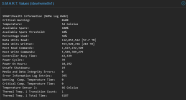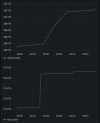Hi,
I noticed by chance today that my NVM SSDs have extremely high wearout. The two disks have been in use for a year and are already at 36%.
I have already searched the forum for similar problems, but couldn't find anything specific that could help me.
can someone help me get to the bottom of this and slow down the wearout.



I noticed by chance today that my NVM SSDs have extremely high wearout. The two disks have been in use for a year and are already at 36%.
I have already searched the forum for similar problems, but couldn't find anything specific that could help me.
can someone help me get to the bottom of this and slow down the wearout.



Code:
root@proxmox:~# zpool get all
NAME PROPERTY VALUE SOURCE
rpool size 952G -
rpool capacity 48% -
rpool altroot - default
rpool health ONLINE -
rpool guid 5390239608252388090 -
rpool version - default
rpool bootfs rpool/ROOT/pve-1 local
rpool delegation on default
rpool autoreplace off default
rpool cachefile - default
rpool failmode wait default
rpool listsnapshots off default
rpool autoexpand off default
rpool dedupratio 1.00x -
rpool free 494G -
rpool allocated 458G -
rpool readonly off -
rpool ashift 12 local
rpool comment - default
rpool expandsize - -
rpool freeing 0 -
rpool fragmentation 43% -
rpool leaked 0 -
rpool multihost off default
rpool checkpoint - -
rpool load_guid 14967033024946245314 -
rpool autotrim off default
rpool compatibility off default
rpool bcloneused 0 -
rpool bclonesaved 0 -
rpool bcloneratio 1.00x -
rpool feature@async_destroy enabled local
rpool feature@empty_bpobj active local
rpool feature@lz4_compress active local
rpool feature@multi_vdev_crash_dump enabled local
rpool feature@spacemap_histogram active local
rpool feature@enabled_txg active local
rpool feature@hole_birth active local
rpool feature@extensible_dataset active local
rpool feature@embedded_data active local
rpool feature@bookmarks enabled local
rpool feature@filesystem_limits enabled local
rpool feature@large_blocks enabled local
rpool feature@large_dnode enabled local
rpool feature@sha512 enabled local
rpool feature@skein enabled local
rpool feature@edonr enabled local
rpool feature@userobj_accounting active local
rpool feature@encryption enabled local
rpool feature@project_quota active local
rpool feature@device_removal enabled local
rpool feature@obsolete_counts enabled local
rpool feature@zpool_checkpoint enabled local
rpool feature@spacemap_v2 active local
rpool feature@allocation_classes enabled local
rpool feature@resilver_defer enabled local
rpool feature@bookmark_v2 enabled local
rpool feature@redaction_bookmarks enabled local
rpool feature@redacted_datasets enabled local
rpool feature@bookmark_written enabled local
rpool feature@log_spacemap active local
rpool feature@livelist enabled local
rpool feature@device_rebuild enabled local
rpool feature@zstd_compress enabled local
rpool feature@draid enabled local
rpool feature@zilsaxattr disabled local
rpool feature@head_errlog disabled local
rpool feature@blake3 disabled local
rpool feature@block_cloning disabled local
rpool feature@vdev_zaps_v2 disabled local
Last edited:





